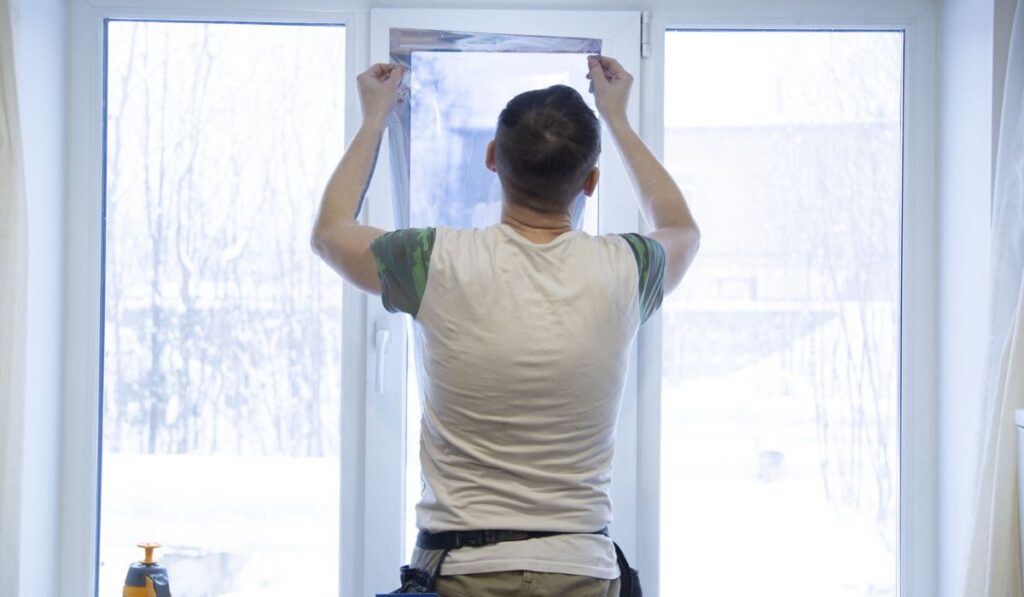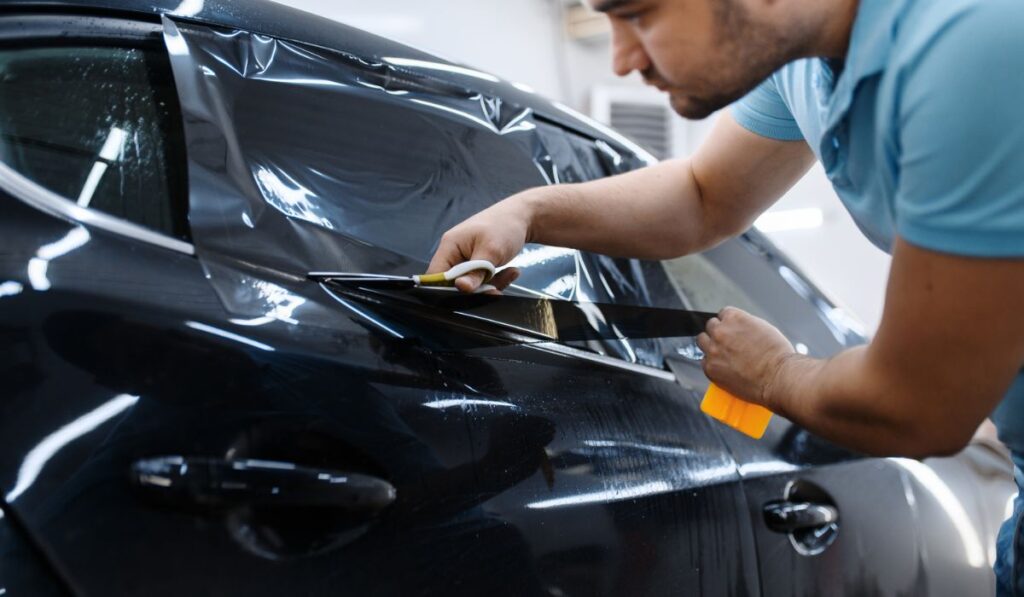Keep away heat from your home during hot months and retain heat throughout cold months using window films. Not only are films easy to install if you choose the DIY way, but they are also an affordable and attractive way to improve your home’s aesthetics, comfort, and privacy.
The five types of window films are privacy, decorative, insulating, spectrally selective, and dual-reflective. Functionality is a significant consideration when deciding what type of film is best for your home. Avoid films containing polyvinyl chloride because of their toxic chemical additives.
Identifying the best window film for your home or car can be challenging. However, several unique types of home window films can enhance the function and improve the beauty of your windows. Keep reading to get insights on the variety of window films available.
5 Common Types of Window Films

Here’s a list of the most common types of window films:
Privacy Window Films
Depending on the level of opacity, privacy films are divided into three major categories:
- Whiteout film: This film is often used in partitioning interior spaces, and they are opaque but look white on both sides, giving your interior spaces a softer mood. Apply whiteout film (on Amazon) in retail environments, bathrooms, and meeting rooms.
- Translucent film: Offers a balance between light and privacy, allowing you to brighten up your space while still enjoying privacy. Typically, this film blurs the images when someone looks from the outside. Translucent films come in different colors and patterns and can be used on interior and exterior doors and windows.
- Blackout film: Blocks nearly all the light that would otherwise brighten up your space, offering privacy from both sides. From the outside, the blackout film gives a reflective look; from the inside, it looks black.
Decorative Films
Say no to boring films with animated decorative films (on Amazon). These films can act like art glass by manipulating the light getting into a room. Select from different decorative designs, patterns, and styles to customize the space.
While many of these films are translucent, they offer UV light protection and minimize glare.
Insulating Window Films
Add an extra insulation layer to your home windows using insulating window films. These films reflect heat inside, distributing it at your pace rather than allowing it escapes through the window.
Insulating window films (on Amazon) reduce the cold spots inside your home by blocking out cold from outside. This drastically reduces your heating costs while increasing indoor comfort during winter.
Not only is insulating window film useful during cold months, but it also helps during hot months. In Summer, this film blocks out extra heat while retaining the air from your AC.
Insulating films help you save money on your energy bills year-round while offering y comfortable indoor stay, regardless of the temperature outside.
Spectrally Selective Films
Enjoy a high UV and IR performance with Spectrally selective films. These films have been engineered to let in a lot of light but block the maximum heat.
Dual-Reflective Films
Give your windows a glossy appearance from outside during the daytime using dual reflective film. This film lets you see what’s outside because only the exterior features a higher reflective surface.
Dual reflective window film (on Amazon) comes in various shades that allow 15% to 35% sunlight infiltration. Whichever specification you choose, you will still enjoy excellent glare reduction. In addition, this film offers privacy during the day and balances hot spots in your space.
What Type of Film is Best for Home Windows?
Functionality is a significant consideration when deciding what type of window film is best for your home. First, determine what’s essential concerning décor, privacy, energy saving, light/darkness, and UV light blocking. Then, combine these features to attain the best results.
Here’s more insight about each of these features:
Material
Most films feature polyethylene terephthalate (PET) as the primary material. Depending on function (blackout, decorative, solar), the film contains different PET layers to achieve the desired outcome.
With this strong polyester material, the film holds up well when exposed to different moisture levels, temperatures, and solvents in cleaners.
Some window films contain polyvinyl chloride (PVC). PVC has toxic chemical additives that can leach out over time, posing health risks, especially for children. When in the market for window film, ensure they are PVC-free.
Aesthetic
Enhance the interior and exterior appearance of your home with decorative films. For example, add decorative film to older windows that appear rundown for a spruced-up look. There’s a wide selection of colors, patterns, and prints to brighten the mood of your home.
Give your bathroom shower, cabinet glass, and French doors a custom look with decorative film. Choose from modern patterns, 3-D designs, frosted film, and bright-colored film designs to transform your home.
Fade Resistance
UV rays can cause your furniture, expensive paintings, and antiques to fade. Even though window film doesn’t stop fading, it drastically slows down and protects costly furnishings.
Degree of Privacy
Films have different degrees of privacy. For example, blackout films offer nearly 100% privacy at all times, while translucent ones obscure the images behind the window. Mirror films reflect light during the day but are transparent at night.
Some decorative films don’t offer privacy but other benefits, such as standard UV protection.
UV Rejection
UV rejection is an important feature to consider since UV rays cause skin damage to inform of skin cancer, dark spots, and wrinkles.
Window film can deflect heat to help you keep energy bills down, controlling internal temperatures while enabling you to enjoy natural light.
What Type of Film is Best for Car Windows?

Improve the cosmetic appeal of the vehicle cost-effectively using window tint. What film is best for your car will be determined by the style you want, and each style offers a customized feel.
Take a look at the following types of window tints to determine which is the best tint for your car:
Dyed Window Tint
Give your car the darkest look with dyed window tint. With a deep black color, this tint looks opaque from the outside.
A dyed window tint (on Amazon) features a layer of dye between the protective top coating and the adhesive layer. Dye tints absorb solar heat, keeping away heat from entering your car.
Unfortunately, dye tint fades over time because of excessive UV exposure. As a result, most people go for dye tints for aesthetics rather than functionality.
Metalized Window Tint
Metalized tint films feature several layers to help reflect heat from the sun. In addition, this tint contains metallic elements with its layers to strengthen your car window and give it a shiny appearance.
Although the tint features several great qualities, its metallic properties often interfere with technology such as radio reception and GPS.
Hybrid Window Tints
Hybrid film (on Amazon) combines metalized and dyed tints. Featuring a dyed layer, hybrid tints can block a significant amount of light. The layer of metalized tint gives the hybrid film a crisp look. In addition, this tint blocks heat, UV rays, and glare.
Carbon Window Tint
Enjoy a matte-black finish that protects your car’s interior using carbon window tint. Featuring hundreds of microlayers of carbon and polymer that block heat from infiltrating the interiors of your vehicle, it protects your upholstery from fading.
The carbon layers keep your car’s interior cool, reducing your reliance on your car’s A/C.
Ceramic Window Tint
Resist glare and fading using ceramic window tint. While it reflects high light levels, this tint allows maximum visibility.
How to Choose Which Window Film is Right for You
Here are factors to consider before choosing window film for your car:
- Purpose: What’s your primary need? Your purpose will inform your choice.
- Price: Price is a significant factor when choosing a window film for your car. Communicate your budget to the installer so they can advise you about your matching options.
- Laws: Certain states in the U.S. limit on darkness, color, or type of tints you can install. Ensure your choice of tint meets your state regulation.
